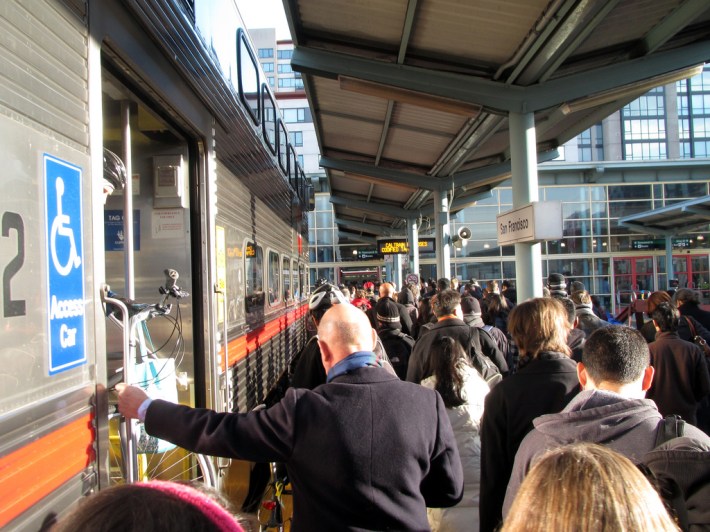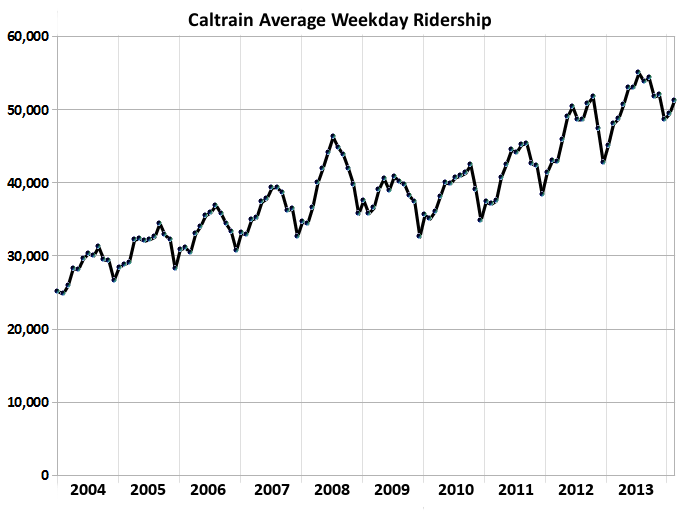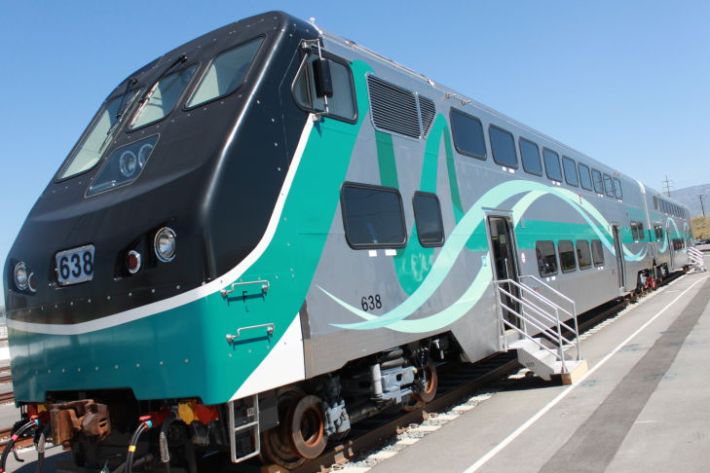
Caltrain's rush hour trains have never been more crowded, which isn't just uncomfortable for riders -- it also discourages potential commuters who instead drive along Peninsula highways, and makes rides more difficult for elderly passengers and riders with disabilities. Commuters could see some relief in 2015, when Caltrain plans to extend the length of some of its trains, but the crunch won't end any time soon if ridership trends continue.
During a typical weekday on Caltrain, the number of trains with more passengers than seats (with passengers left standing) has increased from just two during summer 2010 to over ten trains in summer 2013. The agency estimates that standees account for 10 to 20 percent of passengers on the busiest winter trains, and 30 to 40 percent during the summer.
Caltrain lacks dedicated areas for standing and has no rails or handles to hold on to, so standing on Caltrain is more difficult than on other rail transit systems such as BART. Caltrain's cars are designed to maximize seats, with about 650 on each train, making it easy for commuters to read or work on laptops.
With Caltrain attracting about 4,300 new weekday riders every year since 2010, ridership will reach almost 60,000 on weekdays this summer, and could surpass 75,000 by 2018.

Weekday ridership on Caltrain has more than doubled since 2004, when it began running "Baby Bullet" express services that travel between San Francisco and San Jose in just one hour. Caltrain runs just a few more hourly trains now than it did then, but more of its mid-day local trains have been shifted to rush hour expresses to keep up with the surge in peak-hour, longer-distance demand.
Caltrain most recently expanded service 18 months ago, having cut service in 2009 and 2011 due to budget problems. “In October 2012 we added four trains, going from 86 to 92 weekday trains, which included two trains on the shoulder of the peak," said Caltrain spokesperson Jayme Ackemann. "The goal was to shift people out of the most crowded trains, and to provide some later express trains for tech workers."

To alleviate crowding in coming years, Caltrain is planning to run longer trains using 11 to 16 used train cars to be purchased from Los Angeles Metrolink for $8 to $10 million. By 2015, Caltrain riders could see some five-car trains extended to six-car trains. Those additional train cars would burn more fuel and require more maintenance, but would also boost seat capacity from 650 to 780 seats. Caltrain's two busiest trains started seeing more than 780 passengers per train on typical weekdays since February 2013.
While the 20 percent increase in those trains' capacity would help reduce crowding, the relief won't last long. It took just two years (2011 to 2013) for weekday ridership to jump by 20 percent. That means the upgrade will bring crowding on rush hour trains in 2015 back to 2013's crowding levels.
Caltrain's real capacity boost is poised to arrive in 2019, when the system is converted from diesel to electricity. The new signaling system needed to operate modern electric trains is currently being installed, with workers laying a fiber-optic cable along the length of the railroad. When complete in 2015, Ackemann said that the signal upgrade would allow Caltrain to safely increase the number of trains per hour from five to six.
With electrification in 2019, Caltrain can take advantage of electric trains' faster acceleration and deceleration, allowing it to increase the number of weekday trains from 92 to 114. The number of trains serving the morning rush hour (6 - 9 am) would increase from 27 to 38, and the number serving the evening rush hour (4 - 7 pm) would increase from 30 to 36, according to a proposed post-electrification schedule created by consulting firm Fehr & Peers that has not been released to the public. Nearly every Caltrain station would be served by more weekday trains than today.
But in planning for an electrified system compatible with and shared with California high-speed rail, some transit advocates say the agency isn't giving a close enough look at opportunities to maximize the capacity boost -- key to attracting commuters away from driving on congested Highway 101.
"We want to see Caltrain address the capacity crunch strategically," said Adina Levin, Co-founder of Friends of Caltrain. "Caltrain should be planning for expected ridership based on demand from cities and employers, and proposing capacity improvements to address the demand."

Levin says level boarding platforms and wider trains could provide major increases in Caltrain's capacity. The agency hasn't sufficiently analyzed those measures' costs, timelines, or most importantly, their potential for meeting future ridership demand.
Level boarding places station platforms and train floors at the same level, eliminating steps and saving another five minutes on the San Francisco to San Jose trip, bringing it down to 45 minutes beginning in 2019. "Extra-wide" electric trains, currently being built for use in Europe, could fit 25 percent more seats than today's trains.
Some of the scenarios for electric Caltrain service analyzed in the agency's draft Environmental Impact Report (EIR) on electrification are perplexingly unambitious. Weekday ridership has been growing by over ten percent per year since 2010, but the EIR predicts 69,151 weekday riders in 2020, an annual growth rate of only five percent from 2013 to 2020. At current growth rates, actual ridership will exceed levels predicted for 2020 at San Francisco 4th and King Station by 2016, Mountain View by 2017, and Palo Alto by 2018.
When service to San Francisco's Transbay Transit Center begins in 2022, Caltrain only plans to run two trains per hour to the grand new hub, while up to four other trains would still stop at the existing 4th and King Station. The Transbay Center will have over 100,000 jobs located within a half-mile radius -- more jobs than every other Caltrain station combined.
"This station absolutely must be served by each and every train, and it would be highly counter-productive to terminate any train at 4th and King," wrote Clem Tillier, author of a blog on building a Caltrain system compatible with California High-Speed Rail.
The Caltrain Board of Directors briefly discussed its new ten-year draft Strategic Plan at this morning, but delayed any decision on whether or not to include in it an analysis of the more successful, higher-ridership scenarios described above.




